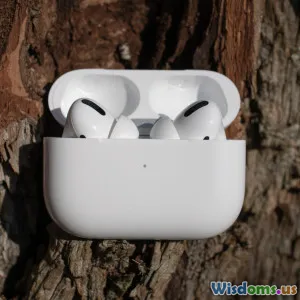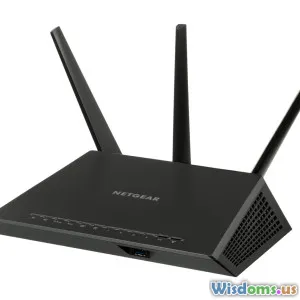
Are Premium Headphones Worth the Hefty Price Tag
18 min read Explore whether premium headphones justify their price with detailed comparisons, real-world insights, and expert advice to help you make an informed auditory investment. (0 Reviews)
Are Premium Headphones Worth the Hefty Price Tag?
Introduction: The Silent Status Symbol
Imagine sitting on a crowded subway, the rattle-and-hum of the city relegated to a distant murmur by the cocoon of your headphones. But not just any headphones: you’re sporting a pair that costs more than your monthly grocery bill. With brand names like Bose, Sennheiser, and Sony subtly announcing your presence, it begs the question — is the immense price tag of premium headphones justified by their performance and build, or is it simply an exercise in luxury branding?
Before you swipe your card or add another pair to your wish list, let’s embark on a journey through the intricate world of high-fidelity audio. Together, we’ll unpack how these earpieces compare to their more affordable cousins, where the money truly goes, and whether your ears and wallet will thank you for splurging.
The Anatomy of a Premium Headphone
Materials & Construction: More Than Just Plastic
It’s easy to dismiss headphone differences as superficial. At a glance, nearly all headphones have similar purposes: to deliver sound. However, premium models typically distinguish themselves from bargain options by virtue of their materials. Rejecting the lightweight plastic common among entry-level headphones, elite models might feature genuine leather, high-grade aluminum, memory foam ear cushions, and even exotic hardwoods. For instance:
- Bowers & Wilkins PX8 ($699.99): Boasts cowhide leather and aluminum for both comfort and longevity.
- Sennheiser HD800S ($1,800): Utilizes proprietary materials like stainless steel mesh and aerospace-grade plastics, contributing to acoustic uniqueness and durability.
- Focal Stellia ($3,000): Handmade in France, using pure beryllium drivers and luxurious Cognac leather.
But do these premium materials only provide aesthetic appeal? Not always. Metal hinges endure the rigors of constant folding; memory foam conforms intimately to your head shape, improving passive noise isolation and long-wearing comfort.
Engineering & Technology: Pursuing Sonic Perfection
Behind those plush earcups lies an array of sophisticated engineering. Premium headphones are frequently outfitted with larger, custom-tuned dynamic drivers — some even experiment with planar magnetic or electrostatic drivers.
- Planar Magnetic Drivers: Used by Audeze LCD-X ($1,199), provide high accuracy and less distortion thanks to their thin diaphragm and precision magnets.
- Noise Cancelling: The flagship Sony WH-1000XM5 ($399) employs QN1 processors and multiple microphones for best-in-class active noise cancelation.
- High-Resolution Audio: Brands include dedicated DACs (Digital-to-Analog Converters), enabling playback of studio-quality, lossless files.
Innovations like touch controls, app-based custom EQ, and automatic environmental sound calibration come as standard on many high-end models. These enhancements amount to genuinely improved user experiences—think seamless Bluetooth multipoint connectivity, extended battery life, and smarter integration with voice assistants.
Sound Quality: Can You Really Hear the Difference?
The Objective: Measuring Performance
It’s tempting to reach for marketing hype when discussing sound, but the industry hinges on measurable parameters: frequency response, distortion levels, and signal-to-noise ratios. Clarity, detail retrieval, instrument separation, and bass response are all quantifiable — and premium models nearly always outperform budget competitors here.
Example:
- Sennheiser Momentum 4 ($350): Offers a wider frequency range (6Hz-22kHz) compared to budget models (often capped at 20Hz-20kHz).
- Soundstage: Premium headphones like the HD800S create an immersive “3D” sensation, letting listeners place instruments within a virtual space, ideal for classical and jazz enthusiasts.
The Subjective: Listening Is Personal
But it’s not all numbers. In a 2022 blind test by What Hi-Fi?, listeners consistently preferred the sound signature of premium headphones when given classical, jazz, and lossless pop tracks to sample. That said, results varied with genres:bass-heavy EDM or rap fans weren’t always as impressed by ultra-precise, reference-tuned cans.
Quote:
“With premium headphones, you often rediscover details in your favorite track’s recording that were previously masked—breaths, the subtle decay of cymbals, backup singers in the far background… this is the magic of high-end headphones.” – Will L. Reeves, Audio Engineer
Can Everyone Appreciate the Difference?
Not everyone perceives the jump in quality equally. Age, hearing loss, and even streaming quality can limit the ability to notice finer sonic distinctions. If your music library consists mainly of MP3s or you listen in noisy spaces, high-end sound may not be fully realized.
Features & Intangibles: Beyond Pure Sound
Wireless Tech and Battery Life
Premium wireless headphones leap ahead with leading-edge Bluetooth codecs (like aptX HD, LDAC) which enable higher-quality, near-CD level streaming. With entry-level models, latency, dropouts, and compression artifacts can be more common. Fast charging, 30+ hour battery lives, and intuitive touch controls are standard at the upper tier, further justifying cost.
Active Noise Cancellation (ANC)
A defining differentiator for travelers and office workers, ANC tech can radically reinvent the listening environment. Bose’s QuietComfort Ultra Headphones ($429) and the Apple AirPods Max ($549) both deliver virtual silence on flights or commutes, often ranking more than 10 dB better in noise suppression compared to mid-tier alternatives.
Brand Ecosystem & Customer Service
Premium brands frequently bundle longer warranties, rapid repair/replacement programs, and access to “ecosystem” benefits, such as seamless pairing with laptops, tablets, and smart TVs. For example, Apple’s AirPods Max integrate seamlessly with all Apple devices—for some, a frictionless tech experience is priceless.
The Status Symbol Factor: Form Follows Function or Flex?
While the allure of superior build and performance is real, there’s an undeniable element of status in sporting high-end headphones, much like a luxury watch or designer sneakers. For many, names like ‘Bose’ or ‘Bang & Olufsen’ signal a certain tech sophistication and a willingness to invest in quality, even if the jump in material cost isn’t strictly proportional to retail price.
Economists call this the “Veblen good” effect—consumers are sometimes willing to pay extra for exclusivity alone, not because materials or engineering match the cost. Limited editions (e.g., Focal Utopia Tournaire edition for $120,000) and celebrity collaborations enhance this aura of exclusivity.
Cost-Benefit Analysis: Where Does the Extra Money Go?
Research & Development
Significant funding enters before the first headphone even ships — extensive sound tuning, custom driver design, new comfort materials, rigorous reliability tests, and software development. According to Sennheiser, every flagship design undergoes thousands of prototype measurements over several years.
Manufacturing & Quality Control
Hand-crafted assembly and meticulous testing, often in small European or US-based facilities, ensure consistency and long life, factors far costlier than mass assembly in lower-wage regions. This approach is evident in brands like Audeze and Focal, compared to generic OEM lines prevalent in low-end options.
Marketing, Distribution & After-Sales Support
Finally, the sleek packaging, in-store demo stands, generous return windows, and service personnel are all baked into the sticker price. A $30 pair of generic headphones sold on Amazon likely skips these investments.
Who Should Buy Premium Headphones?
The Audiophile & Music Enthusiast
For those who relish sound detail, own high-quality sources (like FLAC libraries or a dedicated DAC), and perhaps dabble in music creation, premium headphones consistently represent better value over years of regular use. Their purchase can inject routine listening with new excitement and depth.
Frequent Travelers & Remote Workers
If you value peace and focus — in airports, on planes, or open-offices — invest in models with elite noise canceling. Twenty minutes of tranquility during a cross-Atlantic flight or a productivity boost during work calls may more than justify the upfront expense.
Style-Conscious Users
Some invest for aesthetics or branding — not inherently wrong, particularly if headphones become part of your daily style. Think of it as functional jewelry.
Enthusiastic Gamers and Content Creators
For gamers, spatial audio and low latency are transformative — feeling a racing car zip past or pinpointing an enemy’s location in a game truly impacts experience. Quality headphones can double as a professional tool for streamers and creative editors who require reliable, consistent monitoring.
When Budget Headphones Make Sense
Casual Listeners
Streaming Spotify at 128kbps while multitasking in busy environments? You might not extract full value — here, mid-range brands like Anker, JBL, or Skullcandy offer reliable options under $70, sometimes with basic noise-canceling and sufficient sound for podcasts or commuting.
Kids and Rough Use Cases
Lose headphones at a staggering rate? Spill prone, gym-goer, or gifting a teen? Cheaper sets are less guilt-inducing if lost or broken. Some sub-$100 options continue to punch above their weight (e.g., Soundcore Life Q30, acclaimed for performance per dollar).
Value vs. Diminishing Returns
It is essential to note the law of diminishing returns applies: Improving from $20 to $120 offers night-and-day difference in quality and features. Extending to $300 or more brings further refinement and luxury, but less dramatic improvement. Above $700, enhancements often become subtle, catering to the audio elitist rather than every listener.
Practical Examples: Side-By-Side Comparisons
| Model | Approx. Price | Driver Type | Active Noise Canceling | Battery (hours) | Notable Features |
|---|---|---|---|---|---|
| Sony WH-1000XM5 | $399 | Dynamic | Yes | 30 | Top ANC, LDAC, 8 mics, comfy |
| Bose QuietComfort Ultra | $429 | Dynamic | Yes | 24 | TriPort design, Clear voice calls |
| Apple AirPods Max | $549 | Dynamic | Yes | 20 | Apple ecosystem Sync, Digital Crown |
| Sennheiser HD560S (wired) | $220 | Dynamic | No | N/A | Reference sound, lightweight |
| Soundcore Life Q30 | $80 | Dynamic | Yes | 40 | Value for money, crazy battery |
Comparing these, premium models dominate in build, features, and acoustic refinement, yet the jump from upper-midrange ($220) to flagship ($400–$600) increasingly caters to connoisseur-level demands.
Real-World Insights: User Experiences & Data
A 2021 survey by Statista revealed only 9% of users invested $200 or more in headphones, yet those who did reported the highest satisfaction ratings (88%) and kept their sets 2–3x longer, implying enduring return on investment.
Forum discussions, such as those on Head-Fi or Reddit’s r/headphones, routinely emphasize how moving to audiophile-grade equipment rekindled passion for music:
“I was skeptical until I tried them. Now, I hear parts of the song I never knew existed. Was it worth paying $400? For me, yes—every day I use them.” – u/silentquetzal, Reddit user
What Industry Pros Say
Sound engineers, professional reviewers, and orchestral musicians overwhelmingly advocate for quality headphones as a legitimate avenue to “hear music as the artist intended,” even if acknowledging that past a certain price, returns may be personal rather than strictly practical.
Conclusion: Should You Splurge?
Premium headphones are not for everyone, but for the right customer, they genuinely deliver exceptional sound, comfort, and build while maintaining social cachet and reliable support. Consider them not only as audio gear but as an investment in daily moments of joy, focus, and inspiration.
Yet, value depends on your habits, needs, and priorities:
- Audiophiles, creators, frequent travelers: Likely to extract the most joy and utility.
- Casual, background listeners: Sensible to select from budget or midrange models unless comfort or style is especially valued.
In the end, if your day regularly revolves around sound—be it music, monitors, meetings, or media—investing in a premium headphone can offer rare delight every time you slip them on. The pleasure, immersion, and tranquility they deliver may make the price seem not so hefty after all.
Rate the Post
User Reviews
Popular Posts



















